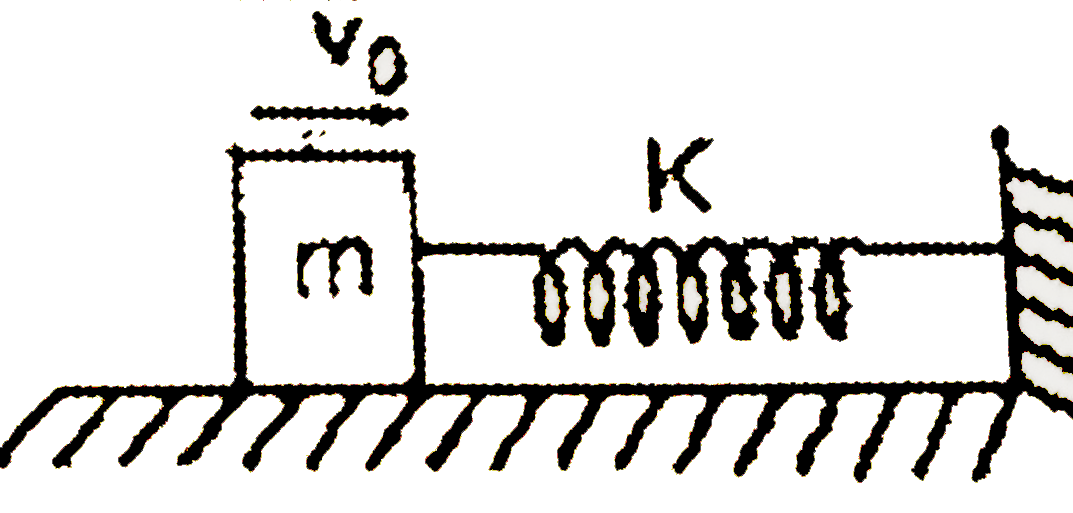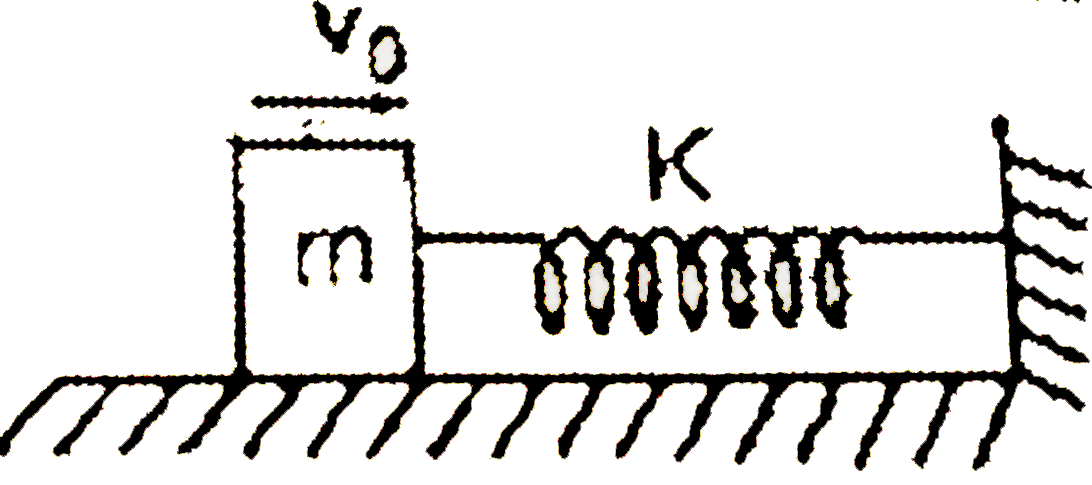A block of mass m moving with a velocity v0 on a smooth horizontal surface strikes and compresses a spring ofstiffuess k till mass coines to rest as shown in the figure. This phenomenon is observed by two observers :
(a) Standing on the horizontal surface
(b) standing on the block

Accoording to the observer A :
the kinetic energy of the block is converted into the potential energy of the spring
the mechanical energy of the spring-mass system is conserved
the block loses its kinetic energy because of the negative work done by the conservative force of spring
all of the above
The correct Answer is:D
Step by step video, text & image solution for A block of mass m moving with a velocity v_(0) on a smooth horizontal surface strikes and compresses a spring ofstiffuess k till mass coines to rest as shown in the figure. This phenomenon is observed by two observers : (a) Standing on the horizontal surface (b) standing on the block Accoording to the observer A : by Physics experts to help you in doubts & scoring excellent marks in Class 11 exams.
Updated on:21/07/2023Topper's Solved these Questions
Similar Questions
A block of mass 10 kg, moving with acceleration 2m/s2 on horizontal rough surface is shown in figure

View SolutionIn the fig 4.24 a block of mass m moves with velocity v0 toward a stationaly block of a mass M on a smooth horizontal surface. Find the maximum compression in the spring of stiffnesss constant K.

View Solution
Knowledge Check
A block of mass m moving with a velocity v0 on a smooth horizontal surface strikes and compresses a spring ofstiffuess k till mass coines to rest as shown in the figure. This phenomenon is observed by two observers :
(a) Standing on the horizontal surface
(b) standing on the block

According to observer B, the potential energy of the spring increases :Adue to the positive work done by pseudo-forceBdue to the positive work done by normal reaction between spring and wallCdue to the decrease in the kinetic energy of the blockDall of the aboveA block of mass m moving with a velocity v0 on a smooth horizontal surface strikes and compresses a spring ofstiffuess k till mass coines to rest as shown in the figure. This phenomenon is observed by two observers :
(a) Standing on the horizontal surface
(b) standing on the block

To an observer B, when the block is compressing the spring :Avelocity of the block is decreasingBretardation of the block is increasingCkinetic energy of the block is zeroDall of the aboveA block of mass m moving with a velocity v0 on a smooth horizontal surface strikes and compresses a spring ofstiffuess k till mass coines to rest as shown in the figure. This phenomenon is observed by two observers :
(a) Standing on the horizontal surface
(b) standing on the block

To an observer A, the net work done on the block is:A−mv20B+mv20C−12mv20Dzero
A block of mass m moving with a velocity v0 on a smooth horizontal surface strikes and compresses a spring ofstiffuess k till mass coines to rest as shown in the figure. This phenomenon is observed by two observers :
(a) Standing on the horizontal surface
(b) standing on the block

To an observer A the work done by spring force is:
View SolutionA block of mass m moving with a velocity v0 on a smooth horizontal surface strikes and compresses a spring ofstiffuess k till mass coines to rest as shown in the figure. This phenomenon is observed by two observers :
(a) Standing on the horizontal surface
(b) standing on the block

To an observer A, the work done by the normal reaction N between the block and the spring on the block is :
View SolutionA block of mass m moving with velocity v0 on a smooth horizontal surface hits the spring of constant k as shown. Two maximum compression in spring is

View SolutionA block of mass mis kept in an elevation which starts1 moving downward with an acceleration aas shown in figure. The block is observed by two observers A and B for a time interval t0

According to the observer A :
View SolutionA force of 50N acts in the direction as shown in figure. The block of mass 5kg, resting on a smooth horizontal surface. Find out the acceleration of the block.

View Solution
